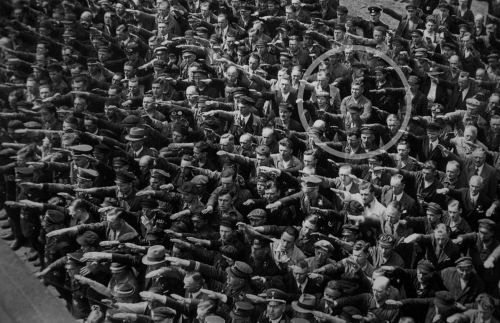I ran across this photo on Twitter the other day, without any caption or explanation. It turns out it was taken on June 13, 1936 at the Blohm + Voss shipyard in Hamburg, Germany. A newly completed training vessel was being launched that day and all of the workers assembled to witness the launch and give the Nazi salute.
And although there are a few people in the photo not giving the salute, the man in the middle of the circle is emphatically refusing to give the salute (click the photo for a larger version).

The man is believed to be August Landmesser who originally joined the Nazi Party in 1931, but was expelled due to his relationship and subsequent attempt to marry a Jewish woman. According to Wikipedia’s summary of Landmesser’s life and death,
August Landmesser was the only child of August Franz Landmesser and Wilhelmine Magdalene (née Schmidtpott). In 1931, hoping it would help him get a job, he joined the Nazi Party. In 1935, when he became engaged to Irma Eckler (a Jewish woman), he was expelled from the party. They registered to be married in Hamburg, but the Nuremberg Laws enacted a month later prevented it. On 29 October 1935, Landmesser and Eckler’s first daughter, Ingrid, was born.
A now-famous photograph, in which a man identified as Landmesser refuses to give the Nazi salute, was taken on 13 June 1936.
In 1937, Landmesser and Eckler tried to flee to Denmark but were apprehended. She was again pregnant, and he was charged and found guilty in July 1937 of “dishonoring the race” under Nazi racial laws. He argued that neither he nor Eckler knew that she was fully Jewish, and was acquitted on 27 May 1938 for lack of evidence, with the warning that a repeat offense would result in a multi-year prison sentence. The couple publicly continued their relationship, and on 15 July 1938 he was arrested again and sentenced to two and a half years in the concentration camp Börgermoor.
Eckler was detained by the Gestapo and held at the prison Fuhlsbüttel, where she gave birth to a second daughter, Irene. From there she was sent to the Oranienburg concentration camp, the Lichtenburg concentration camp for women, and then the women’s concentration camp at Ravensbrück. A few letters came from Irma Eckler until January 1942. It is believed that she was taken to the Bernburg Euthanasia Centre in February 1942, where she was among the 14,000 killed; in the course of post-war documentation, in 1949 she was pronounced legally dead, with a date of 28 April 1942.
Meanwhile, Landmesser was discharged from prison on 19 January 1941. He worked as a foreman for the haulage company Püst. The company had a branch at the Heinkel-Werke (factory) in Warnemünde. In February 1944 he was drafted into a penal battalion, the 999th Fort Infantry Battalion. He was declared missing in action, after being killed during fighting in Croatia on 17 October 1944. Like Eckler, he was legally declared dead in 1949.

